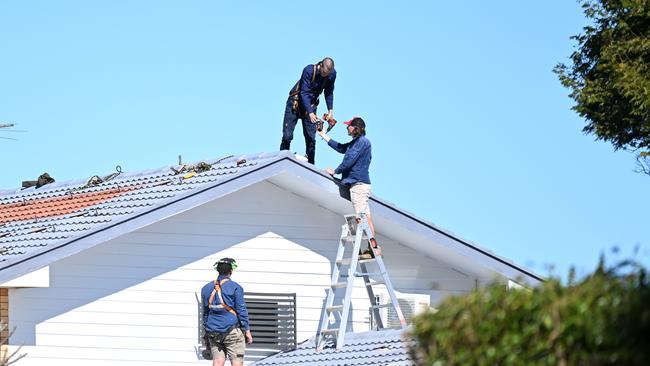Prepare for renewables jobs boom
Three major waves of job creation are in the offing: solar and wind power development; transformation of regional centres; and the wider adoption of electrical devices at home and in industries.

Australia’s shift to clean energy is accelerating, and with the federal government’s May budget allocating significant funding to make the nation a renewable energy superpower, it brings into focus the job creation opportunities, skills needs and workforce challenges that lie ahead.
Dr Chris Briggs, an expert in climate, energy and labour markets at the University of Technology, Sydney, says there’s a large-scale opportunity for job creation – “but a lot of uncertainty about how big it will be”.
Renewable energy jobs could increase from 20,000 to 60,000, he says, under the Australian Energy Market Operator’s Step Change scenario, which envisions a consistently fast-paced shift from fossil fuels to renewable energy in the National Energy Market – a scenario broadly aligned with the federal government’s targets. But in an even more ambitious scenario, it could increase to 250,000 jobs under AEMO’s Hydrogen Superpower scenario, which anticipates a fourfold increase in NEM electricity generation to support the hydrogen export industry.
Briggs says there are three major waves of change that will significantly impact job creation: the build-out of new infrastructure like solar and wind power; the transition of industrial regional centres such as Gladstone in Queensland and the Hunter region in NSW; and the electrification of homes, commercial buildings and industry, and the increasing adoption of electric vehicles.
Although job creation data for the home and office wave is sparse, Briggs says, “It doesn’t take much to realise the amount of work needed – such as electrifying hot water, vehicles and rewiring homes.”
As for which jobs will be in highest demand, Briggs says, “In one word – electricians. Electricians are everywhere when it comes to the transition. They are in shortage and everywhere. Get your kids to become electricians.”
This sentiment is supported by Jobs and Skills Australia estimates, which predicts 32,000 more electricians will be needed by the end of the decade.
Briggs says for large-scale renewables the need is for tradespeople, technicians, and mechanical jobs such as those in wind farms, and construction management.
Wind farms are the biggest source of employment due to their labour intensity and the proportion of the energy mix, he says. Solar farms are less labour-intensive, requiring a small group of electricians and many entry-level and semi-skilled workers to do the assembling and siteworks.
Yet there are shortages across most occupations needed, Briggs says, with huge demand for similar workers across other sectors amid an unprecedented infrastructure pipeline, but also fierce competition globally within the clean energy sector.
Considering this demand, the supply side needs attention, he says. There is limited training capacity and both vocational training and university education are essential.
“We’ve allowed vocational training to decline over the past decade,” he says.
Regarding opportunities for individuals in traditional energy sector roles to re-skill, Briggs says coal power stations have a small, ageing workforce of around 5000 people and are heavily reliant on contractors.
“The challenge lies with operators of power stations who have sector-specific skills. Retraining this ageing workforce is tricky, but it’s feasible to redeploy mobile trades and contractor groups.”
In the mining workforce, the transition will be longer-term, Briggs says. There will be new types of mining with critical minerals for clean energy technologies. Trades can be retrained, but a large group of semi-skilled machine operators and truck drivers will pose a challenge.
Beyond jobs in renewable energy, the clean energy transition opens opportunities for Australia in high-value manufacturing. Mineral processing for all critical minerals is one of the key opportunities.
Briggs says there is a significant opportunity to create a diversified battery supply chain from start to finish. With deposits in nine out of 10 minerals needed, Australia has a unique advantage, including cost benefits from co-locating mining and manufacturing. This could encompass mining jobs, mineral processing, high-value-added manufacturing and end-of-life recycling.
Wind tower manufacturing presents another opportunity, albeit with lower added value.
The local market, worth between $20bn-$80bn based on AEMO’s scenarios, could be partly supplied domestically, Briggs says, reducing reliance on international supply chains and building on existing steel capacity in regions like the Hunter and Illawarra.
The solar supply chain also offers potential, he says.
Despite China’s dominance, Australia’s innovators and world-leading R&D could create global businesses by scaling quickly and finding niches.
In a significant step in supporting the clean energy transition, the federal government’s May budget included funding to accelerate the growth of new industries through the establishment of a $1.7bn Future Made in Australia Innovation Fund and a 10-year extension of funding to the Australian Renewable Energy Agency.
It also provides a $44.4m Energy Industry Jobs Plan and $134.2m for skills and employment support in key regions, among other measures.
According to the Clean Energy Council, it is the “biggest clean energy budget in Australia’s history and will unlock tens of thousands of clean energy jobs and place renewables, green metals and critical minerals at the heart of our economic future.”
